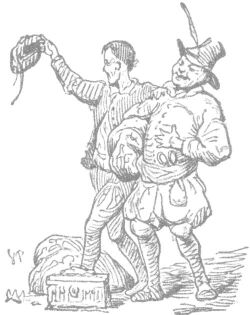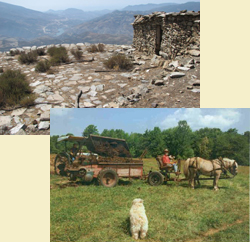« The Left and the Zioncons | Home | Introduction to Systems Thinking »
Two Folktales for Comprehending Late Stage Capitalism and its Scientific Culture
By Karl North | January 17, 2010
Karl North 2006
Folktales distill the wisdom of the ages. All too often their teachings are applicable to any era. Perhaps their continuing relevance comes, as the saying goes, from the human propensity to repeat history, once as tragedy, again as farce.
My favorite tales to explain the hilarious but tragic human behavior patterns of late stage capitalism[1] are The Sorcerer’s Apprentice and The Emperor’s New Clothes.
The Sorcerer’s Apprentice
This tale has been relevant enough to be reworked as novels, music, and poems from the time of ancient Greece to Faustian Europe, and was further immortalized in an early Disney cartoon-musical, Fantasia, where I first encountered it at the impressionable age of eight.
The tale begins as an old sorcerer departs his workshop, leaving his apprentice with chores to perform. The apprentice (Mickey Mouse in the Disney version) tires of fetching water for a bath or tank, and enchants a broomstick to do the work for him, using magic he is not yet fully trained in.  However, soon the floor is awash with water, and he realizes that he cannot stop the broom because he does not know the magic word to make it stop. Despairing, he splits the broom in two with an axe, but each of the pieces takes up a pail and continues fetching water, now faster than ever. When all seems lost in a massive flood, the old sorcerer returns, quickly breaks the spell and saves the day.[2]
However, soon the floor is awash with water, and he realizes that he cannot stop the broom because he does not know the magic word to make it stop. Despairing, he splits the broom in two with an axe, but each of the pieces takes up a pail and continues fetching water, now faster than ever. When all seems lost in a massive flood, the old sorcerer returns, quickly breaks the spell and saves the day.[2]
Modern science at the beck and call of high finance has created ever more powerful technologies whose primary goal is to maximize return to capital for an ever-richer investor oligarchy. Trumpeted to the public as a cornucopia of progress, these technologies initially appear true to promise. But like apprentice magic, they often bring tragic consequences in time. And there is no sorcerer to return, break the spell, and return everything to normal.
It is easy to conceive of a scientific establishment driven by different forces, ones that put public well-being of present and future generations before private profit. So the present situation isn’t a function of the nature of science, but rather of the nature of capitalism. Instead of surrounding us with piles of nuclear radiation, persistent organic pollutants, an asphyxiating transportation system, and industry that fouls the global nest with unrecyclable garbage, unsafe food, and an ever more degraded natural resource base, scientists, guided by the precautionary principle, could design technologies that are careful of the health of the systems on which our continued well being depends. But that would require scientific institutions structured to fit a holistic paradigm of scientific inquiry, where an understanding of the dynamics of systemic context sufficient to model ripple effects governs technology design. Unlike the primarily reductionist science practiced today, which fits hand-in-glove with the short-sighted goal of capitalist profit, a scientific community devoted to holistic design would take more seriously the reality that in complex systems, cause and effect are distant in time and space. For decision making in the real world, specialized knowledge is useless and even misleading without a way to gauge the consequences of decisions across broad interconnected wholes and much later in time.
Mickey the apprentice panics and chops his broom into pieces, which bloom into many brooms that only accelerate the flood. Likewise our scientific reflex is to put band-aid after band-aid on technologies that never were healthy or sustainable in their original design.
An example of reductionist science run amok is the current massive die-off of domesticated honeybees. Driven by the capitalist market economy, scientists have advised beekeepers to increase the size of bees, to increase productivity. Organic farmers who have regressed their bees back to a size developed in a long peasant tradition, do not experience problems. Aiming for maximum productivity in isolation from other variables, scientists have genetically supersized most other domesticated plants and animals in agriculture as well, and with about the same results. The huge high production dairy cows of today are plagued with a well-researched constellation of problems, and would be uneconomical in an economy whose policy framework made the marketplace accountable for ecological and social costs.
The Emperor’s New Clothes
Many years ago there lived an emperor who was quite an average fairy tale  ruler, with one exception: he cared much about his clothes. One day he heard from two swindlers named Guido and Luigi Farabutto that they could make the finest suit of clothes from the most beautiful cloth. This cloth, so they said, also had the special capability that made it invisible to anyone who was either stupid or not fit for his position.
ruler, with one exception: he cared much about his clothes. One day he heard from two swindlers named Guido and Luigi Farabutto that they could make the finest suit of clothes from the most beautiful cloth. This cloth, so they said, also had the special capability that made it invisible to anyone who was either stupid or not fit for his position.
Being a bit nervous about whether he himself would be able to see the cloth, the emperor first sent two of his trusted men to see it. Of course, neither would admit that they could not see the cloth and so praised it. All the townspeople had also heard of the cloth and were interested to learn how stupid their neighbors were.
The emperor then allowed himself to be dressed in the clothes for a procession through town, never admitting that he was too unfit and stupid to see what he was wearing. He was afraid that the other people would think that he was stupid.
Of course, all the townspeople wildly praised the magnificent clothes of the emperor, afraid to admit that they could not see them, until a small child said:
This was whispered from person to person until everyone in the crowd was shouting that the emperor had nothing on. The emperor heard it and felt that they were correct, but held his head high and finished the procession.[3]
Today’s oligarchies wield the myth-spinning tools of modern empire so well that to date, few can see the naked truth as the child, and finally the multitude, did in the Hans Christian Andersen folktale. Like the believers in the invisible clothes of the emperor we accept a disneyland stage show in place of real democracy. We are repeatedly stampeded into wars by fake events and false information designed only for that purpose. We accept crumbs from the pillage of poorer nations in the false belief that our prosperity is only the product of American ingenuity, and bears no relation to the violence we inflict on the peripheries of the empire. We cling to the belief that elections put power into our hands when 5% of the people own 95% of the wealth. How can this be?
The incessant increase in elite wealth and power over more than two centuries has gradually structured government, media, education, and the knowledge business to serve the same needs as those of the tailors in the folktale: the manufacture of a mythical version of reality in the collective consciousness. Bred in the competitive world of advertising, a sophisticated industry devoted to the design of tools of mass deception has developed, which have become the preferred method of modern elite rule. The takeover of our minds happens so gradually that, like the frog in the slowly heating kettle of water, we never realize that our brains are slowly being boiled alive.
The brains of the scientific community are not immune from conversion to mush. In the USSR during the Stalinist era, the agronomist Trofim Lysenko oversaw the prostitution of genetics to serve ideological needs of the party, causing great damage to the progress of Soviet agriculture.
In the USA during the capitalist era economists and political scientists have presided over a similar great intellectual crippling of their disciplines to serve a dominant class of private capital holders. As a result of this American Lysenkoism, renegade economist Hazel Henderson calls training in the mainstream of her discipline “brain damage”.
Economists define their discipline as the social science that studies the production, distribution, and consumption of goods and services. As any anthropologist knows, in virtually all of the many millennia of human history, societies practiced a wide variety of ways of organizing access and distribution of scarce resources, and none of them evolved the type of organization that began to appear in the last few centuries: a regime of values where the value of everything depends on its market price, where use-value surrenders to the stamp of commodification, where everything material and even ideas become ‘property’, and where even hold-out niches to protect such relics as ‘family values’ eventually succumb to market fundamentalism.
Instead of a wide-ranging inquiry into the various ways humans have organized (or could organize) the distribution of scarce resources, and how this distribution affects the distribution of power and other impacts that might concern members of society, mainstream economics offers only vocational training for doing business in this peculiar economic system, and just enough science of market mechanisms to serve that goal and the broader political goals of the capitalist class.
Worse, a primary assumption of capitalist economics – that there are no limits to growth – ignores the laws of thermodynamics, as every physicist and ecologist knows. Rather than admit that material resources can be finite, economists manage to expand them endlessly in their imagination by indulging in a quasi-religious technological fundamentalism. Characteristic of this thinking is the argument in Nobel Prize winning economist Julian Simon’s book The Ultimate Resource that since the capacity of the human mind to solve problems is limitless (sic?), it follows that there are no material limits on humanity (sic!).
Why elevate the study of this apparent aberration to the status of ‘science’? When, like the child in the folktale, will enough people come forth to blurt out, “But the ‘science’ of economics has no clothes!”
Of late, Lysenkoism has taken root with a vengeance in biological science. Early in the development of the gene splicing method of genetic engineering, a few courageous scientists pointed to plentiful evidence that its underlying assumptions were false: genes don’t act alone (one gene on one protein) but in concert, and in complex interactions with environmental variables. Finally, over ten years too late, this inconvenient but unavoidable truth now has become so glaring that the establishment press had to acknowledge it A Challenge to Gene Theory, a tougher Look at Biotech (NY Times 7-2-07). An insatiable industry devoted to the commodification of life has sprung up based on the notion of one gene = one function, a typical product of reductionist science. The revelation that this assumption is false should logically bring down the whole industry and the patenting and privatization of genetic material based on it. But if the biotechnology industry continues to operate according to patterns of behavior characteristic of late stage capitalism, we can expect it to ignore this news.
[1] Capitalism as used here signifies a total social order that includes not only a characteristic political economy or policy framework, but also basic economic, governing, educational/scientific, and media institutions and cultural values distinctive of that social order.
[2] http://www.answers.com/topic/the-sorcerer-s-apprentice
[3] A synopsis of the Hans Christian Anderson tale
Topics: Core Ideas, Political and Economic Organization, Recent Additions, Systems Thinking Tools | No Comments »


